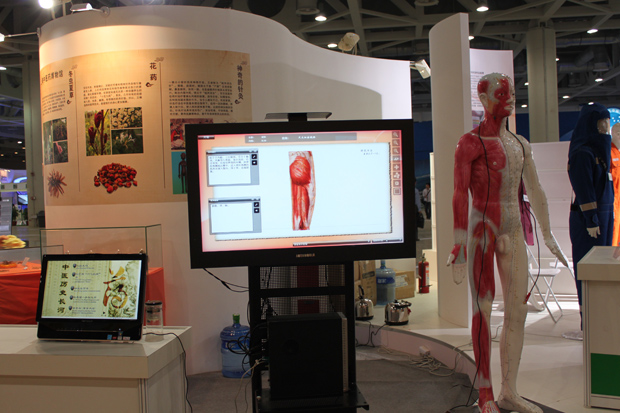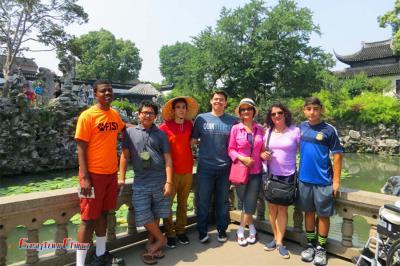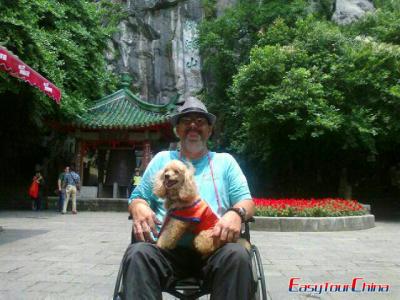Shanghai Museum of Traditional Chinese Medicine
Established in 1938, The Shanghai Museum of Traditional Chinese Medicine is located at the Shanghai University of Traditional Chinese Medicine in Zhangjiang Hi-Tech Park in Pudong New Area. Its three-story exhibition halls occupy about 4,000 square meters. Reputed as the largest professional Traditional Chinese Medicine museum in the world with the most exhibits, Shanghai Museum of Traditional Chinese Medicine boasts more than 14,000 exhibits and almost 10,000 Traditional Chinese Medicine documents.
The museum promotes traditional Chinese medicine (TCM) and the culture of traditional Chinese medicine, popularizes the scientific knowledge of traditional Chinese medicine, reflects the track of traditional Chinese medicine from formation to prosperity, from inheritance to innovation. Shanghai Museum of Traditional Chinese Medicine is the epitome of extensive and profound traditional Chinese medicine and TCM culture.
Shanghai Museum of Traditional Chinese Medicine Facts

Shanghai Museum of Traditional Chinese Medicine Halls & Exhibits
Shanghai Museum of Traditional Chinese Medicine comprises of 3 parts: Shanghai Traditional Chinese Medicine University (China Medicine Association Medicine History Museum), Chinese Medicine Specimen Exhibition Hall and University History Exhibition Hall. The museum has 9 exhibition areas and activity rooms for popular science, as well as library room, multi-function lecture hall, cultural relics warehouse, multimedia demonstration and teaching facilities.
The Museum of Traditional Chinese Medicine in Shanghai is China's earliest professional TCM museum, with 14000 pieces of cultural relics of Chinese medicine from the new Stone Age, including more than 6000 ancient and modern medical books, such as The Inner Canon of Huangdi, Treatise on Febrile Disease and Compendium of Materia Medica, more than 3000 copies of newspapers/species, many of which are rare traditional Chinese medicine publications in 1920s and 1930s.
When visiting Shanghai Museum of Traditional Chinese Medicine, go forward along the engraving and you will arrive at the main hall of the museum. An abstract sculpture of the theory of the five elements will come into view in the center of the lobby. Behind the central sculpture is a relief carving of Jing, Qi and Shen. Jing, Qi and Shen are regarded as the three vital elements of the human body. Jing is the "essence" and considered the source of life. They are derived from ancient Chinese philosophical concepts formed before the birth of Traditional Chinese Medicine.
Medical History Hall
After looking around, turn left and go upstairs. Here you will find the Medical History Hall, which is the earliest and largest on Traditional Chinese Medicine history in China. It was founded in July 1938. The hall presents the development of Traditional Chinese Medicine chronologically during the last 5,000 years.
This hall consists of six parts: the origin of traditional Chinese medicine (from ancient times to the 21st century BC), early traditional Chinese medicine (from the Xia Dynasty to the Spring and Autumn and Warring States Periods), the establishment of the basic theories of traditional Chinese medicine (from the Qin Dynasty to The Three Kingdoms period), the all-round development of traditional Chinese medicine (from the Western Jin Dynasty to the Five Dynasties period), the outstanding achievements of traditional Chinese medicine and the innovations of medical practitioners (from the Song Dynasty to the Yuan Dynasty), and the development of traditional Chinese medicine theories and the improvement of the theory of warm diseases (from the Ming Dynasty to the Qing Dynasty) .
Among the exhibits, the copper relief "Echoes of Traditional Chinese Medicine for a Thousand Years", the relief "Essence, Energy and Spirit", the sculpture of Yin-Yang and the Five Elements, the sculpture of medical practitioners and medical activities throughout history, and the scene of the Tang Dynasty's Imperial Medical Office, etc., showcase the outstanding inventions and creations of traditional Chinese medicine and famous medical practitioners in various historical periods.
>> Related reading: The Charm of Chinese Culture: China Icons in the Eyes of Foreigners
The Specimen Hall of Chinese Herbal Medicine
It was founded in 1958. More than 3,000 specimens of Chinese herbal medicine and ready-made herbal products are displayed here. You can see the select herbal or animal medicines, distinguish rare medicinal herbs from counterfeits, learn the names of different TCM, answer questions about TCM and the museum on LCD screens, watch films or attend lectures on TCM in this hall. Besides, you’ll learn the course of the University’s development from May 1966 to October 1976 during the Cultural Revolution in the Exhibition Hall of the History of the Shanghai University of Traditional Chinese Medicine.

The Health and Rehabilitation Hall
It displays medical artifacts and topographies such as the "Internal Power Diagram Explanation" and the "Guiding Exercises Diagram". It reflects the viewpoints and methods of traditional Chinese medicine in emphasizing prevention and post-illness recovery from different aspects such as mental adjustment, regular daily routine, balanced diet, physical exercise, and proper medication.
>> Related reading: Healthy Chinese Food
The Museum of Acupuncture, Moxibustion & Massage
The Acupuncture, Moxibustion & Massage Hall of Shanghai Museum of Traditional Chinese Medicine has treasures on display -- the officials’ names who compiled the Golden Mirror of Medical Master during the reign of Emperor Qianlong of the Qing Dynasty, the famous bronze figures of acupuncture and moxibustion cast in 1744, Stone Age medical appliance - stone needle, Bronze Figures of Ming Tang Diagram engraved in 1665, acupuncture and moxibustion and massage apparatus, etc., revealing the development course and medical achievements of acupuncture and moxibustion and massage in China.
Important collections
The Bronze Figure of Acupuncture and Moxibustion
The “treasure of the museum” of Shanghai Museum of Traditional Chinese Medicine is the bronze figure of acupuncture and moxibustion, which was cast in 1744 in the exhibition hall on the second floor. According to written records, Emperor Qianlong, in order to honor the compiles of the comprehensive medical series - "Medical Canon of the Golden Mirror", custom-made a batch of acupuncture bronze figures. Today, only this complete set with a brocade box remains in China.
This acupuncture bronze figure is a rare example of an old woman's body among the heirloom acupuncture bronze figures, about 46 centimeters high, with a kind face and 580 acupuncture points engraved on the surface of the body. The brocade box is stamped with the emperor's jade seal. The inscription in Chinese and Manchu indicates that the bronze figure was issued to Fuhai, the transcriber of the Medical Zong Jinjian.
Zodiac elements
The Shanghai Museum of Traditional Chinese Medicine has a set of medicine bottles featuring the twelve Chinese zodiac signs. There are 12 pieces, each with a height of 5.6cm, a diameter of 0.6cm and a width of 4.2cm. Straight mouth, flat shoulders, flat bottom. The bottle body is respectively painted with the patterns of the twelve Chinese zodiac signs: rat, ox, tiger, rabbit, dragon, snake, horse, goat, monkey, rooster, dog and pig. The shoulders are respectively inscribed with the characters "Zi", "Chou", "Yin", "MAO", "Chen", "Si", "Wu", "Mo", "Shen", "You", "Xu" and "Hai" (ancient Chinese time periods). They are the containers used by traditional Chinese medicine practitioners to store ready-made medicines.
How to Get to Shanghai Museum of Traditional Chinese Medicine
Take Metro Line 2 to Metro Zhangjiang Hi-Tech Station and transfer to bus Pudong 112 (Cailun Road Huatuo Road Station).
Travel Tips
For safety reasons, the Shanghai Museum of Traditional Chinese Medicine is not open to children in the lower primary grades and kindergarten.
If you’re interested in the Five TCM Therapies and want to experience the TCM diagnosis and treatment such as acupuncture, moxibustion & massage, contact us right now to tailor-make for yourself a Traditional Chinese Medicine culture tour.


